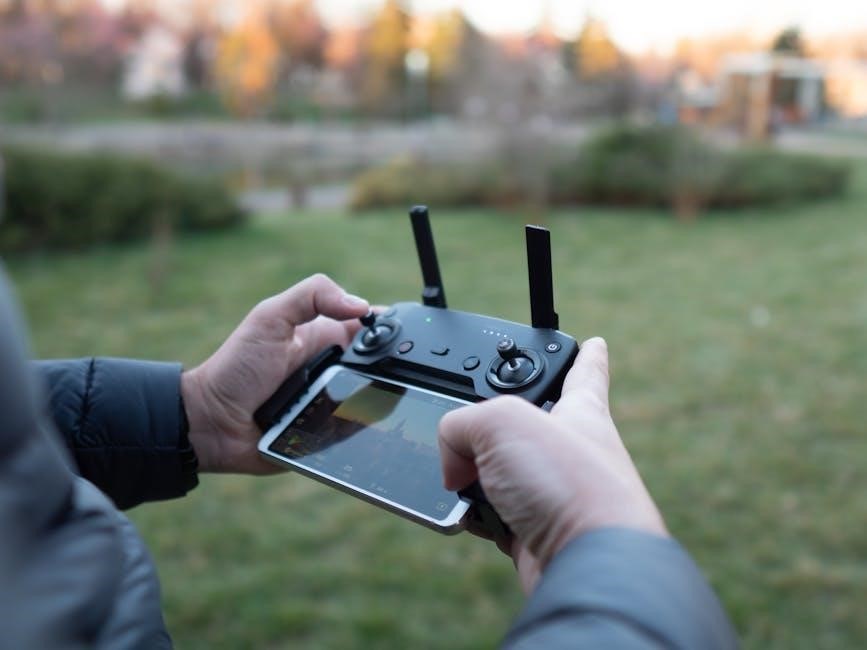The Midas M32 is a high-performance digital mixing console designed for live sound, offering exceptional audio quality and intuitive control. Built with touch-sensitive technology, it delivers professional-grade mixing capabilities in a compact, user-friendly design. Engineered for versatility, the M32 caters to sound engineers, musicians, and live performance applications, ensuring precise control over every aspect of your audio setup.
1.1 What is the Midas M32?
The Midas M32 is a professional digital mixing console designed for live sound applications, offering 32 input channels and 16 MIDAS preamps. It combines intuitive operation with advanced features like a 7-inch touchscreen, motorized faders, and a comprehensive effects suite. Built for versatility, the M32 is ideal for sound engineers, musicians, and live performance venues. Its compact design and robust construction make it suitable for both portable and fixed installations. With a focus on delivering pristine audio quality, the M32 integrates seamlessly with MIDAS hardware and software ecosystems, providing a powerful tool for modern audio production and live mixing environments.
1.2 Overview of the Console
The Midas M32 console features a sleek, ergonomic design with a 7-inch high-resolution touchscreen, 16 motorized faders, and a dedicated master section. The intuitive layout includes clearly labeled controls for channel processing, effects, and routing. The console is divided into sections: the channel strip, master controls, and navigation interface. Each channel offers comprehensive EQ, compression, and gating options. The touchscreen provides direct access to all parameters, while the faders allow precise level control. Rear-panel connectivity includes XLR, TRS, and USB interfaces, ensuring versatile integration with external devices. Built with durability in mind, the M32 is designed for both portable and fixed installations, making it a reliable choice for live sound and studio applications.

Key Features and Benefits
The Midas M32 offers 32 input channels, 8 DCA groups, and 16 mix buses, delivering flexible routing and processing. Its high-quality preamps and effects ensure pristine audio reproduction, while the intuitive interface enhances workflow efficiency for live and studio applications.
2.1 Number of Channels and Buses
The Midas M32 is equipped with 32 input channels, each featuring a high-quality MIDAS preamp, phantom power, and extensive processing options. The console also includes 16 mix buses, comprising 8 DCA groups, 6 mute groups, and 2 solo buses. Additionally, there are 6 matrix buses for flexible routing and monitoring. The 8 DCA groups allow for easy control of multiple channels, while the 16 mix buses provide ample flexibility for creating submixes, handling effects sends, and managing complex audio setups. This configuration ensures the M32 is well-suited for both live sound and studio applications, offering a high degree of customization and control.
2.2 Effects and Processing Options
The Midas M32 offers an extensive suite of built-in effects and processing tools, including high-quality reverb, delay, chorus, and flanger. Each channel features a 4-band parametric EQ, allowing precise tone shaping. Additionally, the console includes a dynamics section with compressor, gate, and limiter on every channel, ensuring optimal control over audio levels. The M32 also supports 6 internal stereo effects processors, which can be routed to any channel or bus. These effects are fully adjustable, offering professional-grade sound enhancement. Furthermore, the console supports scene and snapshot recall, enabling quick access to custom configurations. This comprehensive processing capability makes the M32 ideal for achieving polished, professional audio in live and studio environments.
2.3 Connectivity and Interface Options
The Midas M32 offers extensive connectivity options, ensuring seamless integration into various audio systems. It features 32 MIDAS preamps, 16 analog XLR outputs, and 8 DCA groups for flexible signal routing. The console supports dual AES50 network ports for connecting to stageboxes and other devices, while Ultranet allows direct connection to personal monitoring systems. Additionally, the M32 includes a USB interface for recording and playback, as well as MIDI control for external devices. The console also supports Dante, MADI, and ADAT cards for expanded digital connectivity. With its versatile interface options, the M32 is ideal for both live and studio applications, providing unparalleled flexibility in audio routing and control.

System Requirements and Compatibility
The Midas M32 operates seamlessly with Windows and macOS systems, requiring minimal hardware specifications for optimal performance. Ensure compatibility with the latest software updates for enhanced functionality and stability.
3.1 Operating System Requirements
The Midas M32 is compatible with both Windows and macOS operating systems. For optimal performance, Windows users should run version 10 or later, while macOS users require version 10.13 or newer. Ensure your system is updated with the latest service packs and updates to maintain compatibility. The console’s software and drivers are designed to work seamlessly with these operating systems, providing a stable and responsive mixing environment. Regularly check for firmware updates to ensure you have the latest features and improvements. Compatibility across platforms allows for flexible use in various professional settings, whether in live sound or studio applications.
3.2 Hardware Requirements
To operate the Midas M32 effectively, ensure your system meets the necessary hardware specifications. The console requires a compatible computer or control surface, with a USB 2;0 or higher port for connection. A reliable Ethernet network is essential for remote control via Midas apps. Additionally, a stable power supply is crucial to prevent interruptions during use. For expanded I/O capabilities, consider adding Midas DL32 or DL16 stageboxes. Ensure your setup includes high-quality audio interfaces or snakes if required. A dedicated network switch is recommended for multi-console or large-scale setups. Always use genuine Midas accessories to maintain optimal performance and reliability;
3.3 Software Compatibility

The Midas M32 requires a compatible computer or control surface with a USB 2.0 or higher port for connection; A stable Ethernet network is essential for remote control via Midas apps. Ensure a reliable power supply to prevent interruptions. For expanded I/O, consider adding Midas DL32 or DL16 stageboxes. High-quality audio interfaces or snakes may be needed for external connections. A dedicated network switch is recommended for multi-console setups. Always use genuine Midas accessories to maintain performance and reliability. These hardware requirements ensure seamless operation and optimal audio quality during live performances and recordings.

Setting Up the Midas M32
Setting up the Midas M32 is straightforward, ensuring a seamless experience for live sound applications. This guide walks you through the process, ensuring optimal performance and ease of use to help you get started quickly and effectively.

4.1 Unboxing and Initial Inspection
When unboxing the Midas M32, carefully inspect the console and its components for any visible damage. Ensure all accessories, such as the power cable, USB interface, and documentation, are included. Gently remove the protective covering and clean the console’s surface with a soft cloth. Power on the M32 to verify the touchscreen and LED indicators are functioning properly. Familiarize yourself with the control layout, including faders, encoders, and navigation buttons. If any issues are detected, contact Midas support immediately. Proper inspection ensures a smooth setup process and optimal performance for your live sound needs.
4.2 Connecting Peripherals
Connect your peripherals to the Midas M32 by identifying the appropriate ports. Use XLR or TRS connectors for microphones and instruments, ensuring secure connections to the channel inputs. For MIDI control, connect compatible devices to the MIDI In/Out ports. Network connectivity is established via the Ethernet port, enabling remote control and integration with other Midas devices. USB ports allow for connecting flash drives or computers for firmware updates or data transfer. Always use high-quality cables to maintain signal integrity. Power on the console and test all connections to ensure proper functionality. Properly connected peripherals are essential for optimal performance and reliability during live sound applications.
4.3 Installing Drivers and Software
Install the necessary drivers and software to ensure seamless operation of the Midas M32. Download the latest drivers and Midas M32 Mix software from the official Midas website. Run the installation wizard and follow the on-screen instructions to install the software. Connect the console to your computer via USB during the installation process to establish proper communication. Once installed, launch the software to configure settings and update firmware if required. Ensure your operating system is compatible with the software. Restart your system after installation to apply changes. For troubleshooting, refer to the user manual or official support resources. Proper installation ensures optimal performance and functionality of the Midas M32.
4.4 Configuring Network Settings
Configuring network settings on the Midas M32 enables remote control and seamless integration with other devices. Access the network menu via the console’s touchscreen or connected computer. Set the IP address manually or use DHCP for automatic configuration. Ensure the subnet mask and gateway are correctly entered to match your network. For remote control, install the Midas M32 Mix app on your tablet or smartphone and connect it to the same network. Test connectivity by pinging the console’s IP address. If issues arise, restart the console and router, or consult the user manual for troubleshooting steps. Proper network configuration ensures reliable performance and remote functionality.

Understanding the User Interface
The Midas M32’s user interface is designed for intuitive operation, featuring a touch-sensitive display, logical layout, and customizable controls. It provides easy navigation and efficient workflow management.
5.1 Layout and Navigation
The Midas M32 features a sleek, ergonomic design with a logical control layout. The touch-sensitive display is centrally located, providing easy access to all primary functions. The console is divided into distinct sections, including the channel strip, master controls, and custom user buttons. Navigation is intuitive, with clear visual feedback and responsive controls. Users can quickly move between channels, effects, and scenes using the touchscreen or dedicated hardware buttons. The interface is designed to minimize complexity, allowing sound engineers to focus on mixing without unnecessary distractions. Customizable workflows further enhance efficiency, making the M32 adaptable to various live sound environments and user preferences.
5.2 Channel Strip Overview
The Midas M32 channel strip is a comprehensive control interface for each audio channel, offering precise adjustment of gain, EQ, dynamics, and effects. Each channel features a dedicated fader, mute, and solo buttons, along with a rotary encoder for fine-tuning parameters. The touchscreen display provides visual access to detailed settings, including parametric EQ curves and compression thresholds. Users can also assign custom labels to channels for easy identification. The channel strip integrates seamlessly with the console’s overall design, allowing for intuitive adjustments during live performances. This centralized control ensures that engineers can make quick, accurate changes to individual channels without navigating through complex menus.
5.3 Master Section Controls
The Master Section of the Midas M32 provides centralized control over the entire mix, featuring a master fader, solo, and mute buttons for the main output. A comprehensive metering section displays output levels, ensuring accurate monitoring of the final mix. The AFL (After Fader Listen) and PFL (Pre-Fader Listen) buttons allow engineers to monitor individual channels or the main output directly. Additional controls include adjustments for the main output levels, subgroup masters, and matrix outputs. The master section also integrates with the console’s touchscreen, offering quick access to critical functions. LED indicators provide visual feedback for mute, solo, and signal status, while custom labels can be assigned for personalized workflow efficiency. This section is essential for managing the overall sound during live performances.
5.4 Display and Touchscreen Functionality
The Midas M32 features a high-resolution, full-color touchscreen display that provides intuitive control over all mixing functions. The responsive touchscreen allows for precise adjustments, such as EQ curves and compression settings, with the touch of a finger. The display offers clear visual feedback, including channel strip overviews, metering, and effect parameters. Users can navigate effortlessly through menus and customize their workflow by organizing frequently used functions. The touchscreen integrates seamlessly with physical controls, ensuring a smooth and efficient mixing experience. Additionally, the display supports multi-touch gestures, enabling quick access to advanced features. This combination of visual clarity and tactile control enhances productivity during live performances and studio sessions.

Recording and Playback
The Midas M32 offers robust recording and playback capabilities, enabling seamless capture of live performances and studio sessions. With intuitive controls and flexible routing options, it ensures high-quality audio reproduction and efficient workflow management for professional and precise results.
6.1 Setting Up for Recording
To set up the Midas M32 for recording, begin by connecting your audio interfaces or recording devices to the console’s appropriate ports. Ensure all channels are properly configured and labeled for easy identification. Navigate to the Setup menu and select the Recording tab to configure routing options, such as assigning specific channels or buses to your recording device. Set the sample rate and bit depth to match your recording requirements. Enable the Recording Ready option for each channel or bus you wish to capture. Adjust the gain levels and verify signal flow using the Channel Metering display. Finally, test the setup by recording a short audio snippet to ensure everything is functioning correctly.
6.2 Recording Live Audio
When recording live audio with the Midas M32, ensure all channels and buses are properly configured for capture. Use the Scene or Snapshot feature to recall your live setup quickly. Monitor input levels using the Channel Metering and Master Metering displays to avoid clipping. Arm the desired tracks for recording by pressing the Rec button on each channel or bus. The M32 allows for multi-track recording directly to a USB drive or via an external audio interface. During the performance, use the Talkback feature to communicate with performers if needed. After the show, review the recording to ensure all audio was captured correctly.
6.3 Playback and Monitoring
During playback, the Midas M32 allows for precise monitoring of audio signals. Use the Pre-Fader Listen (PFL) and After-Fader Listen (AFL) functions to isolate specific channels or buses for detailed monitoring. Adjust the Monitor Level knob to control the volume of the selected signal. The Solo and Mute buttons enable quick isolation or muting of channels for accurate audio assessment. Utilize the Master Volume to set the overall output level for the main mix. For live performances, the Monitor Mix can be tailored to meet the needs of performers on stage, ensuring optimal audio quality and clarity during playback and monitoring sessions.
6.4 Routing Signals
Routing signals on the Midas M32 is straightforward and flexible, allowing precise control over audio paths. Use the Channel Routing section to assign inputs to specific buses, subgroups, or the main mix. The Routing Matrix provides advanced options for custom signal distribution, enabling signals to be sent to multiple destinations simultaneously. For monitoring, configure Auxiliary Sends to route signals to stage monitors or external processors. The Subgroup and Matrix buses can be used to create custom mixes for specific applications. Ensure all routing is logically organized to maintain clarity and avoid signal conflicts during live or recording sessions.

Effects and Processing
The Midas M32 offers a comprehensive suite of effects and processing options, including reverb, delay, and compression, with flexible assignment to channels and buses for enhanced sound control.
7.1 Types of Effects Available
The Midas M32 offers a wide range of high-quality effects, including reverb, delay, chorus, and compression. These effects are designed to enhance your audio and provide professional-grade sound processing. With multiple variations of each effect type, you can tailor your sound to suit any performance or recording scenario. The console also features advanced dynamics processing, such as gates and limiters, to help control and shape your audio signals. Each effect can be easily assigned to individual channels or groups, allowing for precise control over your mix. The M32’s effects suite is both versatile and intuitive, making it easy to achieve the desired sound.
7.2 Assigning Effects to Channels
Assigning effects to channels on the Midas M32 is straightforward and intuitive. Navigate to the desired channel using the console’s touchscreen or channel encoder. Select the effects section and choose from the available options, such as reverb, delay, or compression. Adjust the effect parameters to suit your needs, and enable the effect by toggling the corresponding button. You can also route effects to auxiliary sends or use them as channel inserts for more precise control. The M32 allows for real-time adjustments, ensuring seamless integration of effects into your live mix. This flexibility makes it easy to enhance individual channels or entire groups with professional-grade processing.
7.3 Using Scenes and Snapshots
Scenes and snapshots on the Midas M32 allow for efficient management of complex mixes during live performances. Scenes store the entire console configuration, including fader levels, effects, and routing, while snapshots capture specific channel settings. To use scenes, navigate to the Scene menu, select a scene number, and press Store to save your current setup. Snapshots can be stored and recalled per channel, enabling quick adjustments without altering the entire scene. This feature is ideal for dynamic performances, ensuring seamless transitions between songs or segments. Scenes and snapshots enhance workflow efficiency and maintain consistency in your mix, even during fast-paced live environments.

Troubleshooting Common Issues
Troubleshooting the Midas M32 involves identifying and resolving common issues like connectivity problems or audio glitches. Restarting the console, checking cable connections, and updating firmware often resolve many issues. Always refer to the official manual for detailed solutions and guidelines to ensure optimal performance and maintain the integrity of your audio setup.
8.1 Common Errors and Solutions
Common errors with the Midas M32 include synchronization issues, channel overload, or firmware incompatibility. To resolve these, restart the console, check cable connections, and ensure all firmware is up-to-date. For synchronization errors, verify that all devices are connected to the same network and that settings match. If a channel is overloaded, adjust the gain levels or use compression. Firmware updates can often fix compatibility problems. Always refer to the official manual for detailed troubleshooting steps. If issues persist, contact Midas support for assistance. Regular maintenance and updates help prevent errors and ensure smooth operation during live performances or recordings.
8.2 Resolving Connectivity Problems
Connectivity issues with the Midas M32 can often be resolved by checking network cables, ensuring proper IP addressing, and verifying router settings. Restarting the console and connected devices can also resolve temporary glitches. If using wireless connections, ensure stable signal strength and minimal interference. For USB or MIDI issues, test the cables on another device or port. Firmware updates may resolve compatibility problems. Consult the manual for network configuration guidelines. If problems persist, reset the console to factory settings or contact Midas support for further assistance. Regularly updating firmware and drivers helps maintain reliable connectivity.
8.3 Resetting the Console
Resetting the Midas M32 console can resolve software-related issues. Start by powering off the console, waiting 30 seconds, and then turning it back on. This power cycle often clears temporary glitches. For a factory reset, navigate to the Setup or Maintenance menu, depending on your firmware version, and select Reset to Factory Defaults. Note that this will erase all custom settings, so ensure you have backed up your configurations. If issues persist, contact Midas support for advanced troubleshooting. Always refer to the official manual for detailed reset procedures tailored to your console’s firmware version.
The Midas M32 offers unparalleled mixing capabilities. For further guidance, explore the official manual, online forums, and certified training programs to maximize your console’s potential and performance.
9.1 Final Tips for Optimal Use
- Regularly update firmware to access new features and improvements.
- Organize scenes and snapshots for seamless transitions during live performances.
- Label channels and groups clearly for quick identification.
- Use mute and solo functions to isolate tracks during mixing.
- Save configurations frequently to avoid data loss.
- Experiment with effects and processing options to enhance audio quality.
- Engage with the Midas community for tips and shared experiences.
- Utilize the console’s remote control options for flexible operation.
9.2 Accessing the Official User Manual
To access the official Midas M32 user manual, visit the manufacturer’s website and navigate to the support section. Download the PDF manual, which provides detailed instructions for setup, operation, and troubleshooting. The manual covers all features, from basic functions to advanced configurations, ensuring comprehensive understanding. It also includes diagrams, shortcuts, and best practices for optimizing your mixing experience. Regularly refer to the manual to explore new capabilities and resolve any operational questions. For the most accurate information, always use the latest version available on the official Midas website.
9.3 Online Forums and Communities
Online forums and communities are invaluable resources for Midas M32 users, offering peer-to-peer support and shared knowledge. Platforms like Facebook groups, Reddit, and specialized audio engineering forums host discussions where users exchange tips, solutions, and experiences. These communities often include experienced sound engineers who can provide real-world advice and troubleshooting guidance. Additionally, many forums feature user-generated tutorials and configuration files that can enhance your workflow. Engaging with these communities allows you to stay updated on best practices and learn from others who have encountered similar challenges. They serve as a complementary resource to the official manual, fostering collaboration and continuous learning among M32 users worldwide.
9.4 Certified Training and Courses
Certified training and courses are excellent ways to deepen your understanding of the Midas M32. Official Midas training programs, offered by certified instructors, cover advanced features, workflow optimization, and troubleshooting. These courses are designed for both beginners and experienced users, ensuring a comprehensive learning experience. Many programs are available online, while others are conducted in-person at authorized training centers. Additionally, some courses include hands-on sessions, allowing you to practice techniques in real-world scenarios. By completing certified training, you can enhance your mixing skills, unlock the full potential of the M32, and gain recognition as a proficient user. Investing in professional training is a great way to maximize your productivity and creativity with the console.
